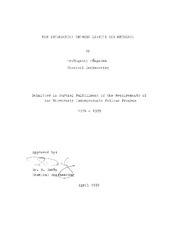| dc.description.abstract | When Methanol is mixed with dried lignite, a vigorous reaction is observed. The reaction is exothermic, and the gas evolved is apparently carbon dioxide. The purpose of this project is to determine the specific amount of carbon dioxide liberated. Two methods were tried: a volumetric method based on the absorption of carbon dioxide using a potassium hydroxide solution and a gravimetric method based on the adsorption of carbon dioxide using Ascarite particles. Texas Lignite from the Big Brown Mine in Fairfield Texas was used in the experiments and the samples were dried bone dry. The lignite particle size was -60+150 mesh for the first method and the -16+60 mesh was used in the second method. Consistent results were not obtained by either method. The most significant problem encountered was that carbon dioxide has a significant solubility in Methanol at low temperature. Thus, when Methanol was trapped or condensed out of the gas in the cold trap so that it could not get into the adsorption bottles, some coarbon dioxide was lost. A better means of trapping or condensing Methanol without losing carbon dioxide has not yet been found.
Another alternative for determining the amount of carbon dioxide was also suggested. The gas evolved from the Lignite-Methanol interaction would be allowed to bubble thru a O.1N solution of a base, e.g. potassium hydroxide or sodium hydroxide. The resulting solution could then be titrated with a O.1N solution of an acid, e.g. hydrochloric acid. The pH of the solution could be recorded as the volume of acid consumed increased. A titration curve could be drawn with the pH of the solution on the ordinate axis and the volume of acid consumed on the abcissa. The volume of carbon dioxide in the solution could then be determined. The dependability of the method has not been proved because of the limitation of the time allowed for the project.
Speculations as to the origin of the carbon dioxide suggested that carbonates in the lignite might decompose and contribute to the gas evolution. When hydrochloric acid was allowed to react with lignite, a gas liberation occurs. This fact is consistent with the idea that the source of the carbon dioxide might be from carbonates. However, when sodium carbonate or sodium bicarbonate was allowed to react with Methanol, no reaction could be detected. No definite conclusion could be drawn until further detailed studies are done. | en |


